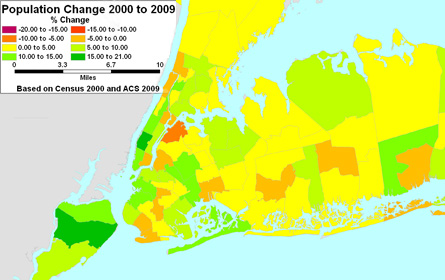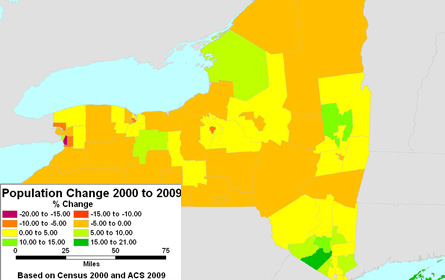

New York state received a nasty surprise from the Census Bureau on Dec. 21. According to the first results from census 2010, the state has 163,351 fewer people than the bureau estimated it did on July 1, 2009. As a result, New York will lose two congressional seats, bringing its total down to 27, tying it with Florida.
The loss of two congressional seats will set off a huge redistricting fight. Beyond representation in Congress, the diminished New York state population will have a major impact on the amount of federal aid that the state receives.
The Missing New Yorkers
If New York's population had matched the July 1, 2009 estimate, it would have lost only one seat. If the estimated rate of growth in the population from 2008 to 2009 had continued to April 1, 2010, then the state would have 19,596,910 residents, some 218,808 more than the 19,378,102 persons who were actually enumerated.

Demographers and politicos are scratching their heads trying to figure out how this happened and what the implications will be. Unlike California, which has already claimed an undercount and protests the census results , New York state is still contemplating the impact and sources of this apparent population loss.
An examination into which parts of the state were overestimated or undercounted is necessary. Once the redistricting data are released in March, we will have much better information.
In general, though, there are three possible explanations:
-- The procedure by which the census creates estimates is flawed.
-- There are problems with the census 2010 count.
-- The 2000 count may have been somewhat inflated, and the new count reflects a return to reality.
Each of these explanations could be true in various ways. The census estimates are based upon births and deaths and international and domestic migration. Immigration -- foreign or domestic -- is particularly hard to capture, and the number of immigrants to New York state may have declined. Foreign immigration would mostly affect the city and downstate, while domestic immigration is important upstate.
New York state has many "hard to count" areas, especially in the city. Though major efforts were made to count residents from these areas, it may be that the backlash from 9/11 and a perceived increase in anti-immigration sentiment led some immigrants to be less willing to participate in the census than they were in 2000. Similar problems may have affected upstate, if the census outreach was ineffective.
Finally, technical issues related to the addition of extra addresses arising from a census check of addresses in 2000 may have led to duplication. If so, it is possible that the city population was somewhat overcounted in 2000. Since the census numbers from 2000 become the base for the census estimates, if those extra addresses were removed or the Census Bureau eliminated more duplicate addresses, then the population in the city, especially in parts of Queens and Brooklyn would be less than was estimated.
Up for Grabs
Whatever the reason for the lower count in New York State, the implications for congressional redistricting are massive. Most of the population losses occurred in upstate New York, while the gains were in areas in and around the city, most particularly in outer ring suburbs.
The table below shows each district's population gain or loss, and some characteristics of the district, including the current incumbent, his or her party, the member's vote in the November elections and the degree to which the districts deviates from the ideal population size of 717,707 people.
| District | Party | Name | Incumbent | 2010 Vote Percentage | Pop 2000 | Estimated Population 2010 | Change from 2000 | Deviation from Ideal | % Deviation |
| 1 | Dem | Timothy Bishop | Yes | 50.05 | 654,360 | 713,122 | 58,762 | -4,586 | -0.64% |
| 2 | Dem | Steve Israel | Yes | 56.60 | 654,360 | 687,889 | 33,529 | -29,819 | -4.15% |
| 3 | Rep | Peter King | Yes | 72.00 | 654,361 | 653,477 | -884 | -64,230 | -8.95% |
| 4 | Dem | Carolyn McCarthy | Yes | 53.70 | 654,360 | 657,810 | 3,450 | -59,897 | -8.35% |
| 5 | Dem | Gary Ackerman | Yes | 62.40 | 654,361 | 699,143 | 44,782 | -18,565 | -2.59% |
| 6 | Dem | Gregory Meeks | Yes | 94.90 | 654,361 | 654,564 | 203 | -63,144 | -8.80% |
| 7 | Dem | Joseph Crowley | Yes | 79.70 | 654,360 | 673,522 | 19,162 | -44,186 | -6.16% |
| 8 | Dem | Jerrold Nadler | Yes | 75.00 | 654,360 | 695,491 | 41,131 | -22,217 | -3.10% |
| 9 | Dem | Anthony Weiner | Yes | 58.50 | 654,360 | 691,231 | 36,871 | -26,476 | -3.69% |
| 10 | Dem | Edolphus Towns | Yes | 91.00 | 654,361 | 680,793 | 26,432 | -36,915 | -5.14% |
| 11 | Dem | Yvette Clarke | Yes | 90.30 | 654,361 | 668,394 | 14,033 | -49,314 | -6.87% |
| 12 | Dem | Nydia Velazquez | Yes | 92.90 | 654,360 | 688,434 | 34,074 | -29,273 | -4.08% |
| 13 | Rep | Mike Grimm | No | 51.50 | 654,361 | 698,637 | 44,276 | -19,071 | -2.66% |
| 14 | Dem | Carolyn Maloney | Yes | 74.90 | 654,361 | 666,335 | 11,974 | -51,372 | -7.16% |
| 15 | Dem | Charles Rangel | Yes | 79.90 | 654,361 | 661,747 | 7,386 | -55,961 | -7.80% |
| 16 | Dem | Jose E. Serrano | Yes | 95.40 | 654,360 | 684,421 | 30,061 | -33,287 | -4.64% |
| 17 | Dem | Eliot Engel | Yes | 72.10 | 654,360 | 668,910 | 14,550 | -48,797 | -6.80% |
| 18 | Dem | Nita Lowey | Yes | 62.00 | 654,360 | 669,824 | 15,464 | -47,883 | -6.67% |
| 19 | Rep | Nan Hayworth | No | 52.80 | 654,361 | 709,848 | 55,487 | -7,859 | -1.10% |
| 20 | Rep | Christopher Gibson | No | 55.40 | 654,360 | 675,617 | 21,257 | -42,091 | -5.86% |
| 21 | Dem | Paul Tonko | Yes | 59.30 | 654,361 | 660,109 | 5,748 | -57,599 | -8.03% |
| 22 | Dem | Maurice Hinchey | Yes | 52.40 | 654,361 | 662,365 | 8,004 | -55,342 | -7.71% |
| 23 | Dem | Bill Owens | Yes | 48.10 | 654,361 | 652,743 | -1,618 | -64,965 | -9.05% |
| 24 | Rep | Richard Hanna | No | 52.90 | 654,361 | 633,497 | -20,864 | -84,210 | -11.73% |
| 25 | Rep | Ann Marie Buerkle | No | 50.20 | 654,361 | 646,863 | -7,498 | -70,845 | -9.87% |
| 26 | Rep | Christopher Lee | Yes | 73.80 | 654,361 | 646,879 | -7,482 | -70,829 | -9.87% |
| 27 | Dem | Brian Higgins | Yes | 60.80 | 654,361 | 624,284 | -30,077 | -93,423 | -13.02% |
| 28 | Dem | Louise Slaughter | Yes | 65.20 | 654,360 | 604,913 | -49,447 | -112,795 | -15.72% |
| 29 | Rep | Thomas Reed | No | 56.50 | 654,361 | 647,243 | -7,118 | -70,465 | -9.82% |
As the table makes plain, Districts 1 through 19 will need to lose one seat, while districts 20 through 29 will lose the second seat. Though District 28, represented by Louise Slaughter, and District 27, represented by Brian Higgins, are the farthest below the new ideal of 717,707, it will require 10 districts becoming only 9 to make upstate districts conform to population equality. Similarly, even though most districts in the downstate area have been growing, the 19 downstate districts will need to become 18 to leave New York with the 27 seats to which it is entitled.
Thanks to the new census count, New York state is now in for two separate games of musical chairs to find out which representatives will no longer have seats to call their own.
Andrew A. Beveridge has taught sociology at Queens College since 1981, done demographic analyses for the New York Times since 1993, and been in charge of Gotham Gazette's demographics topic page since 2000. The opinions expressed are his alone.